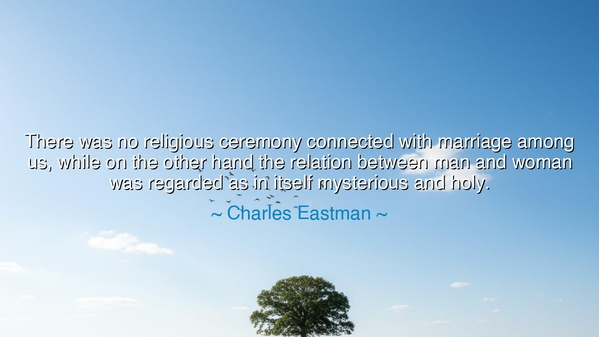
There was no religious ceremony connected with marriage among us
There was no religious ceremony connected with marriage among us, while on the other hand the relation between man and woman was regarded as in itself mysterious and holy.






“There was no religious ceremony connected with marriage among us, while on the other hand the relation between man and woman was regarded as in itself mysterious and holy.” — Thus spoke Charles Eastman, the Dakota physician, writer, and philosopher, whose words bridge the ancient wisdom of his people and the restless modern world. In this reflection, Eastman draws back the veil on the spiritual understanding of his Native ancestors, revealing a truth that humankind too often forgets — that sacredness does not depend upon ritual, and that holiness lies not in ceremony, but in the reverence of the heart.
To understand the meaning of this quote, one must first see through the eyes of the Sioux nation, among whom Eastman was born. In their tradition, marriage was not consecrated by priests or sanctuaries; it was consecrated by the spirit of love itself, by the quiet understanding between two souls bound in harmony with nature and the Creator. For them, love was not something to be legislated or officiated, but a living covenant — mysterious because it sprang from the unseen forces that govern all life, and holy because it united not only two people, but two worlds: the masculine and the feminine, the physical and the spiritual, the human and the divine.
Eastman’s words reflect the deep spiritual simplicity of his people — a way of life where holiness was not confined to temples, but found in the breath of the wind, the flight of an eagle, or the gaze between two lovers. In saying there was “no religious ceremony,” he does not imply absence of reverence; rather, he reveals that in his culture, reverence was constant. They did not need to summon the sacred with ritual because the sacred already lived within all things. In this way, his people were not without religion, but without the walls that divide the sacred from the ordinary. Marriage was thus not a performance before society, but a quiet vow before the Great Spirit, whispered in the language of mutual respect, fidelity, and love.
Consider, then, the contrast between Eastman’s world and that of the colonizing West. In the European tradition, marriage was bound to religious institutions — a covenant sanctified by clergy, witnessed by congregations, and regulated by law. While such structure brought solemnity, it also brought distance — a wall of ritual between the lovers and the mystery of their own union. Eastman’s people needed no intermediary. Their holiness was direct, flowing not from authority, but from awareness — the awareness that the act of union itself, when approached with purity and respect, was already sacred. In their silence, there was depth; in their simplicity, there was divinity.
History offers us many examples of this deeper truth — that love itself, when lived with honor, is greater than any ritual meant to contain it. Think of Antony and Cleopatra, whose bond defied kingdoms and creeds, or Shah Jahan and Mumtaz Mahal, whose devotion inspired the building of the Taj Mahal, a temple of love rather than of religion. Their love, though not perfect, carried the same mystery and holiness Eastman described — a flame that burned not in sanctuaries, but in the hearts of those who dared to give themselves wholly. Love, when true, needs no priest to sanctify it; its sanctity is self-evident, its ceremony written in the stars.
Yet Eastman’s words are not only about marriage; they are about how we see the sacred itself. He challenges us to look beyond the symbols and ceremonies that dominate modern life, and to rediscover holiness in simplicity. The mysterious and holy union he speaks of is not limited to man and woman — it is the union of soul and spirit, of humanity with nature, of the self with truth. He invites us to remember that holiness does not dwell in buildings or books alone, but in the quiet acts of care, in the gaze of love, in the breath that joins one life to another.
So, O listener, let this teaching dwell in your heart: do not seek holiness only in the temples made by hands, for it already lives in the world made by the Creator. When you love, love with reverence. When you make promises, make them with integrity. Recognize that the sacred is not performed — it is lived. Whether in marriage or friendship, in work or worship, treat each relationship as a meeting of divine souls. For as Charles Eastman teaches, when love is born of respect and harmony, it becomes not merely human, but cosmic — not merely emotional, but eternal.
Thus, remember: the world does not need more ceremonies to sanctify love. It needs hearts humble enough to see that love, in its truest form, has always been holy — mysterious, eternal, and beyond the reach of any ritual man can create.






AAdministratorAdministrator
Welcome, honored guests. Please leave a comment, we will respond soon